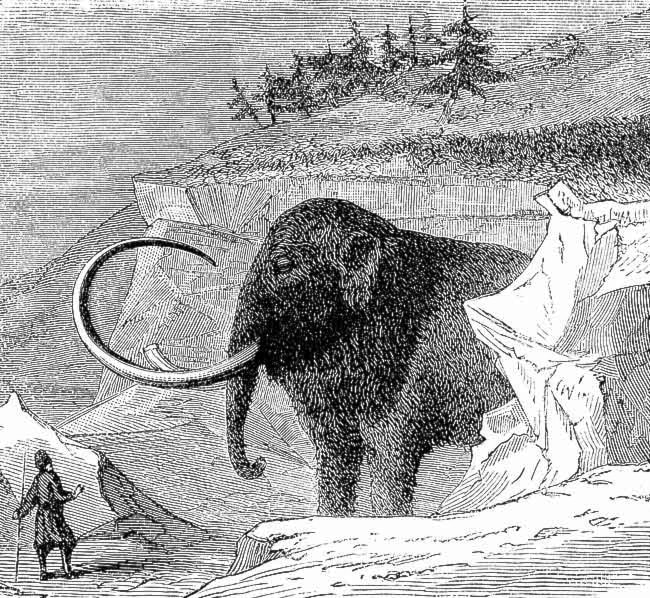In June a US-led team hit the gold fields near Dawson City in search of treasure.
But it was not mineral wealth that drew these explorers — rather, the prize was the genetic material of long-extinct prehistoric beasts.
Unlike conventional paleontologists, the members of the expedition, which includes scientists from New York, Alberta and the Yukon, are not seeking rock or bone fossils.
Instead, using minute analysis of soil samples dated to prehistoric times, the team used cutting-edge technology to identify microscopic DNA evidence of long-extinct woolly mammoths.
“The notion is that you can go to sediments that were laid down at that age where the animals were actively living, and excreting, and dying, and retrieve enough of their DNA in order to come up with an identification,” said Ross MacPhee, an expedition participant and the curator of vertebrate zoology at the American Museum of Natural History.
That means, essentially, that a tiny sample of 10,000 year-old dirt taken from the Dawson gold fields can wield infinitesimally small snippets of genetic information from every single plant and animal that was alive at that time.
“Your challenge is to winnow through all that information to find the species that you’re really interested in,” he said.
On their month-long Yukon expedition, the researchers took 20- to 30-centimetre-long permafrost core samples from a variety of former placer mining sites from throughout the northern Yukon.
These core samples were then frozen and sent to a lab at McMaster University in Hamilton, Ontario — where months of lab work remain to be done.
The new DNA-sifting process, when properly developed, could move paleontology beyond the simple realm of bones, rocks and fossils.
“This represents a new family of techniques which are going to be a really valuable adjunct to conventional paleontology as time goes on,” said MacPhee.
Previous attempts to use the new DNA sampling method have failed, due to breakdowns of DNA evidence, said MacPhee.
But colder northern latitudes promise to wield a much richer bed of genetic code.
“It turns out that DNA preserves comparatively well in persistently frozen soil,” said MacPhee.
If good data can be obtained, MacPhee intends to use it to determine exactly when the first mammoth set foot on the shores of prehistoric North America, and when the last mammoth finally keeled over.
The earliest mammoth fossil so far has been carbon dated to 10,000 years, but the fossil record can only present an extremely small cross section of a species at any one time, said MacPhee.
Reduced populations of mammoths could well have existed even as recently as 5,000 years ago, he said.
With a more complete record of the species, it could all serve to answer the one great woolly mammoth mystery that has plagued scientists for decades.
Mammoths — massive, tusked creatures were well-insulated against ice age conditions by thick shaggy coats.
Fossils found throughout the Northern Hemisphere reveal the creatures were a hearty bunch, and adapted to a range of climates and conditions.
And then, in a flash, they were all gone.
“Why don’t we have these big hairy beasts with us today? What happened, 10,000 years ago, or roughly around then, which resulted in the disappearance of so many of these megafauna?” said MacPhee.
The two leading theories are that they were wiped out by early human hunters, or that they succumbed to the effects of climate change.
The words ‘DNA’ and ‘extinct prehistoric’ beast in the same sentence naturally raise the “Jurassic Park question.” Can DNA from extinct mammoths be used to resurrect living, breathing mammoths in the modern day?
“I get asked that all the time — and I’m going to have to give you the same answer I give all the time, which is that, at present, it’s not feasible, but that doesn’t mean it won’t be, within the space of a decade or so,” said MacPhee.
Three years ago, the concept of prehistoric resurrection moved beyond the realm of science fiction.
In 2005, National Geographic reported a team of Japanese scientists was looking to harvest sperm from a mammoth frozen in the Arctic tundra, and use it to impregnate a contemporary elephant.
Once the mammoth-elephant hybrid was born, the privately funded scientists planned to release the creature into a Siberian safari park for exhibition and study.
But apparently, mammoth sperm is in shorter supply than the Japanese researchers assumed.
MacPhee is staunchly opposed to any attempts at mammoth breeding initiatives.
“What’s the point? At the end of the day is it just to satisfy some sick intellectual curiosity, or does it have an actual goal in mind?” he said.
“All I can say, is that from the vantage point of 2008, it seems technically unfeasible at this point, and it also seems ethically impractical, if not actually wrong to go about doing this without a clear sense of how these animals are going to be cared for.”
